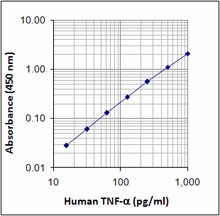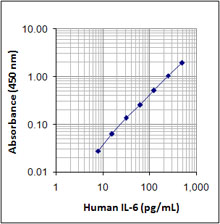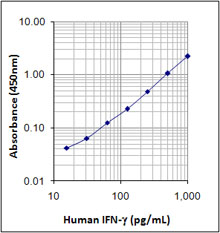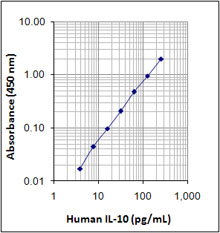- Regulatory Status
- RUO
- Other Names
- TNF-α Pre-coated ELISA Kit
- Ave. Rating
- Submit a Review
- Product Citations
- 6 publications
| Cat # | Size | Price | Quantity Check Availability | Save | ||
|---|---|---|---|---|---|---|
| 430207 | 1 Pre-coated Plate | 328€ | ||||
Human TNF-α (Tumor Necrosis Factor α), also termed Cachectin, Cytotoxic Factor (CF), CTX, Hemorrhagic Factor, Macrophage-Derived Cytotoxic Factor, Macrophage Cytotoxic Factor (MCF), and MCT, is a potent multifunctional cytokine which can exert regulatory, inflammatory and cytotoxic effects on a wide range of normal lymphoid and non-lymphoid cells and tumor cells. TNF-α is secreted by macrophages, monocytes, neutrophils, T-cells (primarily CD4+ T cells), NK-cells, and many transformed cell lines. It exists as a soluble 17.5 kD protein and a 26 kD membrane-associated protein. The soluble form protein derives from the membrane form by proteolytic processing. The membrane form protein, but not the soluble form, is phosphorylated on serine residues. Dephosphorylation of the membrane form occurs by binding to soluble TNFRSF1A/TNFR1. TNF-α binding to surface receptors elicits a wide array of biologic activities including: cytolysis and cytostasis of many tumor cell lines in vitro, hemorrhagic necrosis of tumors in vivo, increased fibroblast proliferation, and enhanced chemotaxis and phagocytosis in neutrophils. It has been shown that TNF-α plays a critical role in many physiological and pathological conditions, including neurodegenerative diseases and cancer.
BioLegend’s LEGEND MAX™ Human TNF-α ELISA Kit is a sandwich Enzyme-Linked Immunosorbent Assay (ELISA), in which, a Human TNF-α specific monoclonal antibody is pre-coated on a 96-well strip-well plate.
BioLegend’s LEGEND MAX™ Human TNF-α ELISA Kit is specifically designed for the accurate quantitation of Human TNF-α from cell culture supernatant, serum, plasma or other bodily fluids. It is ready-to-use, accurate, and sensitive.
Kit Contents
- Kit Contents
-
- Anti-Human TNF-α Pre-coated 96-well Strip Microplate
- Human TNF-α Dectection Antibody
- Human TNF-α Standard
- Avidin-HRP B
- Assay Buffer A
- Wash Buffer (20X)
- Substrate Solution D
- Stop Solution
- Plate Sealers
Product Details
- Verified Reactivity
- Human
- Application
-
ELISA
- Product Citations
-
- Sensitivity
- 3.5 pg/mL
- Standard Range
- 15.6-1,000 pg/mL
- Materials Not Included
-
- Microplate reader able to measure absorbance at 450 nm
- Adjustable pipettes to measure volumes ranging from 1 µL to 1,000 µL
- Deionized water
- Wash bottle or automated microplate washer
- Log-Log graph paper or software for data analysis
- Tubes to prepare standard dilutions
- Timer
- Plate Shaker
- Polypropylene vials
Antigen Details
- Cell Sources
- Activated monocytes, neutrophils, macrophages, T cells, B cells, NK cells, LAK cells
- Biology Area
- Cell Biology, Immunology, Innate Immunity, Neuroinflammation, Neuroscience
- Molecular Family
- Cytokines/Chemokines
- Gene ID
- 7124 View all products for this Gene ID
- UniProt
- View information about TNF-alpha on UniProt.org
Related FAQs
- In your LEGEND MAX™ ELISA Kits, there is a step that calls for washing the plates before adding sample. What is the purpose of this step?
-
We typically use a stabilizer for pre-coated plates. The additional washing step is designed to remove these components before you start the assay. If you do not perform the washing, the effect on assay performance is negligible.
- I have multiple LEGEND MAX™ ELISA kits that I want to run simultaneously. Can I use the same wash buffer for all the kits?
-
The wash buffer provided in all our LEGEND MAX™ kits is the same and the part numbers on the wash buffer bottles in these kits should be identical. For ELISA MAX™ Deluxe and ELISA MAX™ Standard Sets, we provide a recipe for the wash buffer on each kit’s technical data sheet. This recipe is the same for all ELISA MAX™ sets.
- For some of your ELISA kits, why do my serum samples require dilution with assay buffer?
-
In some cases, dilution with assay buffer is required to minimize the matrix difference between the samples and the standards to achieve better accuracy.


 Login / Register
Login / Register 















Follow Us